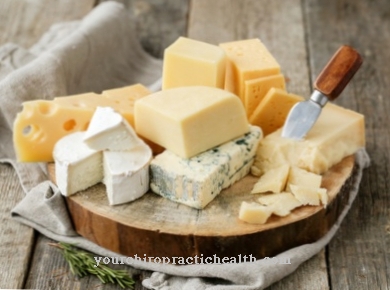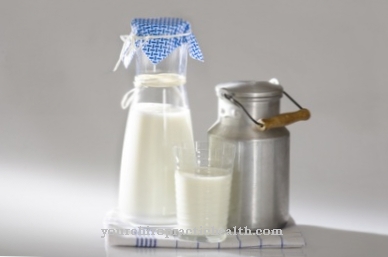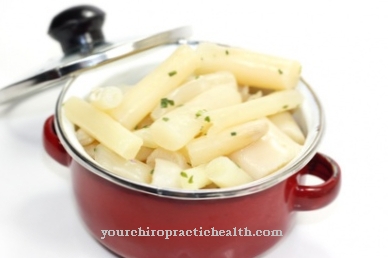The common plate herb is a flowering plant that grows wild in Northwest America and now also in Europe. Due to its high nutrient and vitamin C content, it is still eaten today as a salad or vegetable side dish.
What you should know about common plate herb

The common plate herb belongs to the genus of plate herbs (lat. Claytonia). In German it will too Cuba spinach, Winter purslane or Postelein called. There are a total of 26 different types of plate herbs.
The common plate herb is easy to distinguish from most of these species because the uppermost leaves combine to form a single bract that surrounds the stem. This gives the impression that the flower stalk is growing through the leaf, which the Latin species name "perfoliata" (= through the leaf) also expresses. The remaining leaves are rhombic to ovate and have a long stem. The inflorescence above the collar-like bract consists of 5-40 flowers. The small, mostly white flowers show five petals, which shows that they belong to the plant order of carnations (Caryophyllales). The common plate herb germinates in autumn at temperatures below 12 ° C. Depending on the course of winter, larger plants can be found as early as October, and in cold winters from February. The flowering period lasts from February to May.
At the end of May the plant dies and only the seeds survive the summer in the ground. The plant is edible including its flowers and roots. It tastes mildly sweet and nutty. The common plate herb has retained its preference for cool, not too bright locations from its original homeland, the mountain regions from southern Alaska to Central America. The German name Kuba-Spinach indicates that English settlers brought the plant to Cuba because its consumption provides good protection against scurvy, a vitamin C deficiency. From there it spread to Australia and Europe.
There is evidence that the botanist Archibald Menzies bred specimens of the plant in Kent Garden in 1794 and brought them to Europe. In north and north-west Germany, the common plate herb thrives in fields and gardens as “weeds”, but is also grown in greenhouses and grown for consumption. The common plate herb is the only species of its genus that grows in Europe.
Importance to health
The common plate herb is the first crop that can be harvested at the beginning of a new year and eaten fresh. The Indians and European settlers were able to protect themselves from scurvy with Claytonia, as it has a very high vitamin C content.
This characteristic made him very popular in his country of origin. In this country too, the early ripening of the plate herb helps to bridge the time until the harvest of other crops without having to resort to imported goods. Claytonia has remained a wild plant to this day and has not been changed by human intervention. The plant is therefore small, but compared to other crops it has an unusually high vitamin and nutrient content. As a wild plant, it contains a lot of chlorophyll, the antioxidant components of which bind free radicals and thereby slow down cell aging. Consuming them uncooked increases the release of the happiness hormone serotonin.
As a typical leafy vegetable, Claytonia is low in fat and high in fiber. The common plate herb is often used in its native USA as a component of vegetable smoothies or salads. It is ideal as a herbal companion to a diet or detox treatment. It can also be consumed cooked like spinach.
Ingredients & nutritional values
The common plate herb is a popular wild vegetable in the USA ("Miner‘s lettuce" = "Miner's salad"), which is why its ingredients have been examined by the authorities. Without liquid components (water, fats), the dry matter consists of 37% proteins, 42.5% long-chain carbohydrates (sugar) and 12.4% dietary fiber.
A serving of about 100 g has about 20 kilocalories. This covers 33% of the vitamin C requirement of an adult, 22% of the required amount of vitamin A and 10% of the iron requirement. The plant has a very low content of oxalic acid, a cell poison that is harmful in larger doses and is found in many other vegetables. The protein components include many antioxidant substances from chlorophyll, e.g. Beta carotenes. Claytonia also has a high content of omega-3 fatty acids, calcium and magnesium.
Intolerances & allergies
The most common allergens such as pollen, nuts or gluten do not show any similarity to the ingredients of the common plate herb. Most allergy sufferers can therefore eat this plant without hesitation. However, there are people who suffer from a so-called "salad allergy". The hallmarks are swelling of the oral cavity, skin rashes and discomfort in the gastrointestinal tract.
The allergic symptoms occur after contact with salads (lettuce, chicory), spices (tarragon, cardamom), spiced teas (chamomile, yarrow) and certain types of vegetables (artichoke, black salsify). People with lettuce allergies are not allergic to all of these plants at the same time or to the same extent. Most of the plants belong to the Asteraceae genus, but this is not an exclusion criterion.
Scientists have identified the LPT (lipid transfer protein) Lac S1 as the causative allergen, which is also produced by non-daisy family. Therefore, everyone affected by a salad allergy should be careful when consuming common plate cabbage.
Shopping & kitchen tips
The common plate herb is mostly known in German markets by its vernacular names winter purslane and postelein. However, it does not belong to the Portulaca and is not related to the similar looking summer purslane.
The common plate herb is offered at well-stocked weekly markets and it is often found as a side dish in the vegetable crates that consumers can purchase directly from organic producers. Due to its distribution in northwestern Germany, winter purslane is rarely found in central and southern Germany. The winter purslane offered at markets mostly comes from greenhouses. Since Claytonia perfoliata is now also native to us, you can grow it yourself or harvest it in nature. Anyone who collects the plant in nature should do so at a sufficient distance from roads and other sources of pollution.
Preparation tips
In principle, the whole plant can be harvested and consumed, but the roots should be boiled beforehand. If you don't want to eat the roots, just harvest the leaves. To do this, simply pluck the leaves carefully with the stem. Unless all leaves are removed, the plant can produce new leaves that can later be harvested again. Harvesting can start with young plants from 5 cm and continue until the plant has withered. The leaves can be eaten raw after thorough washing. A number of tasty recipes can be found on the Internet as suggestions for further use.













.jpg)

.jpg)
.jpg)











.jpg)